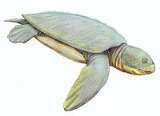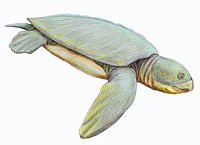
Protostega
Encyclopedia
Protostega gigas is an extinct
species of marine turtle. It was first collected from the Smoky Hill Chalk
of western Kansas
in 1871, and named by E.D. Cope (1872). With a length of 3 m (10 ft), it is the second-largest turtle
that ever lived, second only to the giant Archelon
.
 Like the modern leatherback sea turtle
Like the modern leatherback sea turtle
, the largest living turtle at 2.70 m (9 ft) long, Protostegas carapace
lacked scute
s, making it weaker but also lighter. Protostega probably fed on slow ocean
creatures such as jellyfish
and shellfish
.
Extinction
In biology and ecology, extinction is the end of an organism or of a group of organisms , normally a species. The moment of extinction is generally considered to be the death of the last individual of the species, although the capacity to breed and recover may have been lost before this point...
species of marine turtle. It was first collected from the Smoky Hill Chalk
Smoky Hill Chalk
The Smoky Hill Chalk Member of the Niobrara Chalk formation is a Cretaceous conservation Lagerstätte, or fossil rich geological formation, known primarily for its exceptionally well-preserved marine reptiles. The Smoky Hill Chalk Member is the uppermost of the two structural units of the Niobrara...
of western Kansas
Kansas
Kansas is a US state located in the Midwestern United States. It is named after the Kansas River which flows through it, which in turn was named after the Kansa Native American tribe, which inhabited the area. The tribe's name is often said to mean "people of the wind" or "people of the south...
in 1871, and named by E.D. Cope (1872). With a length of 3 m (10 ft), it is the second-largest turtle
Turtle
Turtles are reptiles of the order Testudines , characterised by a special bony or cartilaginous shell developed from their ribs that acts as a shield...
that ever lived, second only to the giant Archelon
Archelon
Archelon is a genus of extinct sea turtle, the largest that has ever been documented.-Discovery:...
.

Leatherback Sea Turtle
The leatherback sea turtle is the largest of all living sea turtles and the fourth largest modern reptile behind three crocodilians. It is the only living species in the genus Dermochelys. It can easily be differentiated from other modern sea turtles by its lack of a bony shell. Instead, its...
, the largest living turtle at 2.70 m (9 ft) long, Protostegas carapace
Carapace
A carapace is a dorsal section of the exoskeleton or shell in a number of animal groups, including arthropods such as crustaceans and arachnids, as well as vertebrates such as turtles and tortoises. In turtles and tortoises, the underside is called the plastron.-Crustaceans:In crustaceans, the...
lacked scute
Scute
A scute or scutum is a bony external plate or scale, as on the shell of a turtle, the skin of crocodilians, the feet of some birds or the anterior portion of the mesonotum in insects.-Properties:...
s, making it weaker but also lighter. Protostega probably fed on slow ocean
Ocean
An ocean is a major body of saline water, and a principal component of the hydrosphere. Approximately 71% of the Earth's surface is covered by ocean, a continuous body of water that is customarily divided into several principal oceans and smaller seas.More than half of this area is over 3,000...
creatures such as jellyfish
Jellyfish
Jellyfish are free-swimming members of the phylum Cnidaria. Medusa is another word for jellyfish, and refers to any free-swimming jellyfish stages in the phylum Cnidaria...
and shellfish
Shellfish
Shellfish is a culinary and fisheries term for exoskeleton-bearing aquatic invertebrates used as food, including various species of molluscs, crustaceans, and echinoderms. Although most kinds of shellfish are harvested from saltwater environments, some kinds are found only in freshwater...
.

